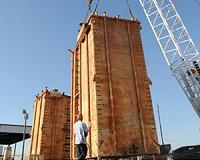| . |  |
. |
Madrid, Spain (SPX) May 11, 2010 Providing alerts in emergency situations is vital to reducing potential fatalities and damage by supplying information about unfolding events and the way to respond to such events. One of the main challenges in these cases is the manner to transmit the notifications to different types of users so that no group- chiefly individuals with a disability, tourists, or individuals that do not understand the language, culture or geography of the affected zone- is excluded if they do not receive this information in a comprehensible manner. Along these lines, the research group at the Department of Informatics Engineering at UC3M has developed an ontology that allows specification of the requisites that must be kept in mind during these situations regarding user characteristics and preferences, the type of emergency, and the environs where they were produced. "It is essential for the notification systems be able to adapt the contents and choose the best means of communication, taking into account these elements in such a way that the number of people affected by lack of information is reduced to a minimum", explained one of the researchers, professor Alessio Malizia, at the Interactive Systems Laboratory in this Madrid university. In this work, the scientists have analyzed the norms for accessibility, the emergency response systems, and the communication mechanisms, taking into account the different abilities of persons to react to distinct types of alarms, in order to generate the fastest and most efficient alert possible. For that purpose, an ontology called SEMA4A (Simple Emergency Alerts for(u)r All), has been designed which allows the existing knowledge to be modeled with respect to a relations graph and which constitutes a knowledge base that could be used in any open form. It can be found in the article "SEMA4A: An ontology for emergency notification systems accessibility", recently published in the scientific journal "Expert system with applications". The main application of this ontology is the development of emergency notification systems which fulfill the principles of universal accessibility and design so that the alerts and all the information pertaining to them, such as evacuation plans, are made accessible to a broader collective. "The intended target for this type of information is not just individuals with disabilities, but also older persons, persons with limited income, individuals with health problems, and refugees, along with other "vulnerable" groups", remarked the Doctor in Computer Science, Alessio Malizia. "Furthermore", he added, "we have to consider the fact that when faced with an emergency we all become contextually disabled. It may be because we can't hear because of noise, or because smoke makes it impossible for us to see, or simply because we are tourists and are not familiar with the area, customs, language, or the safety regulations". This work forms part of the UIA4SIGE (TSI2007-60388) project, financed by the Ministry of Science and Innovation, whose aim is the search for new usability, interoperability and accessibility solutions in information systems for emergency management. Future work proposed by the researchers includes the definition of concepts allowing the prototype elaboration process to be automated, as well as carrying out validations of the accessibility guides included in the ontology. In fact, a new prototype called CAP-ONES has already been developed to automatically adapt alert notifications. A further step would be the application of these same ideas to other similar processes, such as emergency evacuation plans, which could be adapted to user needs.
Share This Article With Planet Earth
Related Links Carlos III University of Madrid Bringing Order To A World Of Disasters A world of storm and tempest When the Earth Quakes
 Top US brains swing behind bid to cap oil spill
Top US brains swing behind bid to cap oil spillVenice, Louisiana (AFP) May 12, 2010 BP battled Wednesday to cap a huge oil leak, lowering a box dubbed "a top-hat" into the Gulf of Mexico amid mounting US anger over a spill flowing unchecked into the sea for three weeks. Frustrated by the failure to staunch the leak, President Barack Obama dispatched a top team to BP's command center in Houston, Texas, to throw the administration's scientific expertise behind the British oil ... read more |
|
| The content herein, unless otherwise known to be public domain, are Copyright 1995-2010 - SpaceDaily. AFP and UPI Wire Stories are copyright Agence France-Presse and United Press International. ESA Portal Reports are copyright European Space Agency. All NASA sourced material is public domain. Additional copyrights may apply in whole or part to other bona fide parties. Advertising does not imply endorsement,agreement or approval of any opinions, statements or information provided by SpaceDaily on any Web page published or hosted by SpaceDaily. Privacy Statement |